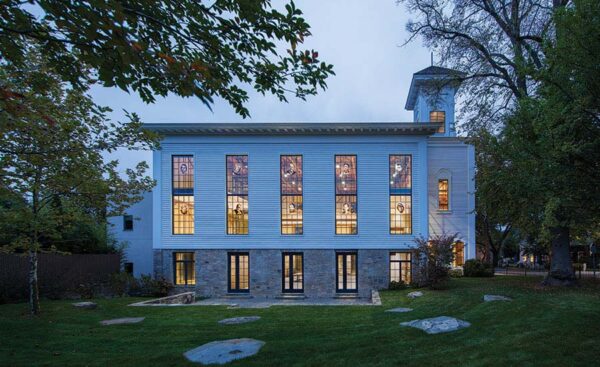
18 Oct TIO NYC: Hamptons on the Fly!
Rounding out a weekend of walks on beaches that seemed to stretch into infinity and fabulous food in historic settings such as the Maidstone Club in East Hampton and the American Hotel in Sag Harbor, a friend and I treated ourselves to a cultural bath, i.e., a day visiting a few of art venues on the East End of Long Island.

Maidstone Club, East Hampton.

Dining room at American Hotel.
What do James Fenimore Cooper, Amaza Lee Meredith, and George Balanchine have in common?

Amaza Lee Meredith, an example of Fischl’s tribute to the “Saints of Sag Harbor.”
The answer is a whale of a tale – in part, literally – which for us began on a weekend trip to East Hampton and a stop in Sag Harbor.
From 1760 to 1850, the town was a thriving whaling port. In fact, for nearly 100 years, Sag Harbor was one of the largest whaling ports in the country, blessed with what whalers dubbed “greasy luck.” That period ended due to falling demand from alternative sources of energy and falling supply due to overfishing, but Sag Harbor continued to thrive, despite the vagaries of enterprise, fires, floods and blizzards, thanks to pristine beaches and centuries-old, tree-lined streets peppered with quietly elegant homes – early Colonial Capes, Greek Revivals and Victorians – whose appearance has remained largely unchanged over the past three centuries.
Forests of masts poking at the heavens from the harbor conspire to create a skyline that recalls the town’s illustrious maritime history.
Sag Harbor also has vibrant and longstanding African-American community and was home to Long Island’s first synagogue. Today, the village is a haven for artists and writers, as it was when Fenimore Cooper, Meredith and Balanchine were locals. As part of that story, the trio is counted among the town’s “Saints,” celebrated today on the windows of one of Sag Harbor’s renovated churches.

Originally built in 1835 as a Methodist house of worship in the Greek Revival style (about five blocks from its current location on 48 Madison Street), The Church, was bought as a deconsecrated white clapboard structure about three years ago by artists Eric Fischl and April Gornik. The couple’s Big Idea? To create a vibrant community arts center and artists’ residency.
Our tour guide was Executive Director and Chief Curator Sara Cochran, as enthusiastic about The Church as young girl finding her first penny in the street. That passion and her deep knowledge of the venue dressed up what could have been a humdrum recitation of just the facts ma’am in knockout blockbuster attire.

(Chochran holds a Ph.D. in the History of Art from the Courtauld Institute of Art in London and has a Masters from Université de la Sorbonne, Paris. Her resume includes Director and Chief Curator at the Scottsdale Museum of Contemporary Art, where she doubled the museum’s annual attendance.)
According to The New York Times:
“…The Church… is a valentine to bygone eras, when Herman Melville haunted the town’s docks and local bars; John Steinbeck relaxed by a wood-burning fire in Harbor Cove with his dog, Charley; Langston Hughes read poems aloud on a friend’s porch; and the sculptor and performance artist Gordon Matta-Clark inhaled fragrant breezes in his mother’s garden. It represents the couple’s effort to restore Sag Harbor as a beacon for all artists….”
Go here for more on the history. And here for more about the town’s luminaries, some well-known; others not so much. Find more about Fischl and Gornik here.
Next stop, the Parrish Art Museum, Water Mill/Southampton:


The Parrish Museum’s collection embraces American art from the 19th century to the present, particularly art created on the island. In creating the new space, Swiss architects Jacques Herzog and Pierre de Meuron set out to capture the sharp, clear light and saturated colors of the sky in their design for the site on the eastern end of Long Island.
One of the current shows at the Parrish is titled “Roy Lichtenstein – History in the Making, 1948–1960″:

One of the most influential and innovative artists of the second half of the 20th century Roy Lichtenstein is identified with Pop Art, a movement he helped originate. His claim to fame is based on paintings of comic strip imagery and advertisements, rendered in a style mimicking the crude printing processes of newspaper production or Benday dots. Those images served to help reinvigorate the American art scene and alter the history of modern art.
Lichtenstein’s success was matched by his focus and energy. After his initial triumph in the early 1960s, the artist went on to create an oeuvre of more than 5,000 paintings, prints, drawings, sculptures, murals and other objects celebrated for their great wit and inventiveness.
But there was a prologue to the Pop chapter of this former Southampton resident.
According to the Parrish:
“‘Roy Lichtenstein: History in the Making’ examines the period before the dot–that is, the artist’s signature use of Benday dots in his Pop paintings. The exhibition reveals how Pop art emerged in dialogue with European modernism, American history painting, and a diversity of vernacular sources.
“The exhibition… also tells the story of Lichtenstein’s brief, but instrumental flirtation with abstraction in 1959 and 1960. Coinciding with the mainstreaming of Abstract Expressionism, these paintings illustrate how the artist was inspired to engage with the movement’s pervasive influence, but not without inserting his characteristic humor and wit.”
Lichtenstein’s earlier work was inspired fairy tales, folk and children’s art. He also drew on various forms of Americana, including representations of cowboys and Native Americans and Disney cartoon characters Bugs Bunny, Donald Duck, and Mickey Mouse. Those and other vernacular inspirations are an essential, though little-known prelude to the artist’s trumpeted appropriations of pop culture.


The pre-Dot work pays tribute to Paul Klee, Bauhaus master and forefather of Surrealism, whose seemingly cockamamie system of pulsing and bobbing otherworldly creatures evolved out of a deeply mystical place and definitely marked some of the very first efforts in the 20th century to embed spiritual content and the subconscious into abstract work.
Note Lichtenstein’s primitivist, 2D style of drawing featuring funny faces, lumpy bodies, and other simplified forms. As one critic noted:
“Lichtenstein’s pre-Pop œuvre (in part) consists of boyish renderings of boyish enthusiasms: battle scenes, mechanical devices, cowboys and Indians, medieval knights, pilots, deep-sea divers…”
On display are some 90 paintings, drawings, sculptures and prints, including many pieces never been shown publicly beyond a limited run at Colby College in February of this year.
“Roy Lichtenstein: History in the Making” is the first major museum exhibition to explore work from this widely overlooked period in the celebrated artist’s career.
Last stop of the day, Peter Marino Art Foundation:

His bio states that the infamously leather-clad, motorcycle-riding designer Peter Marino, FAIA, is the principal of Peter Marino Architect, a 160-person, New York–based architecture practice founded in 1978.
Working globally across a broad range of project types and scales, Marino is widely credited for redefining modern luxury through equal emphasis on architecture and interior design. The practice is recognized for its award-winning residential, retail, cultural, and hospitality projects worldwide. Well known for integrating art within architectural designs, Peter Marino has commissioned more than 300 site-specific works of art.
His site-specific works – like the shimmering chain of glass orbs by the French sculptor Jean-Michel Othoniel referencing the Parisian atelier’s iconic pearl necklace – often feature prominently in the boutiques Marino designs for luxury brands like Louis Vuitton, Dior, Bulgari, and Zegna, a trait that might be considered a natural outgrowth of his passion for accumulating artwork.
Located at 11 Jobs Lane, Southampton, the Peter Marino Foundation is tricked out with a subset of the designer’s massive collection, which supposedly grew legs in 1978 when close friend Andy Warhol gave the then 29-year-old designer a series of seven India ink and watercolor paintings from his flower series in exchange for the renovation of his Upper East Side townhouse.
While the exterior of the landmarked Victorian Gothic-style building of the late 1800s retains its understated red brick facade, the interior is a study in Marino’s baroque style and a testament to the fact that in his rarefied world of celebrity, more is more.


Sorry, the comment form is closed at this time.